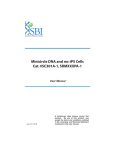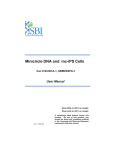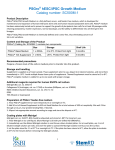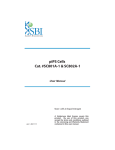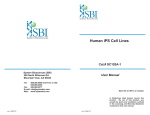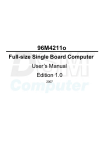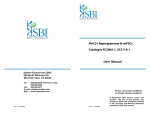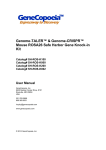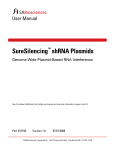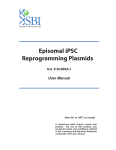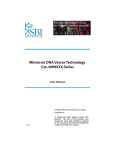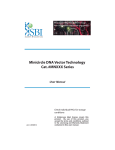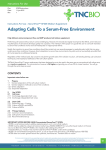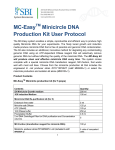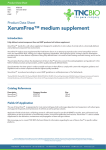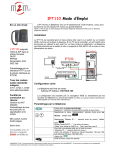Download Minicircle iPSC Technology User Manual
Transcript
Minicircle DNA and mc-iPS Cells Cat. #SC301A-1, SRMXXXPA-1 User Manual ver. 2-111910 A limited-use label license covers this product. By use of this product, you accept the terms and conditions outlined in the Licensing and Warranty Statement contained in this user manual. Minicircle DNA and mc-iPS Cells Cats. # SC301A-1, SRMXXXPA-1 Contents I. Introduction and Background .................................................. 2 A. The Minicircle Technology .................................................. 2 B. Minicircle derived iPS cell line ............................................ 3 II. Protocols ................................................................................. 5 A. Minicircle Production .......................................................... 5 B. Transfection of Minicircle DNA for reprogramming............. 7 C. Growing mc-iPS cells in Feeder-Free Media ...................... 8 III. References........................................................................ 10 IV. Technical Support ............................................................. 11 V. Licensing and Warranty ........................................................ 11 888-266-5066 (Toll Free) 650-968-2200 (outside US) Page 1 System Biosciences (SBI) I. User Manual Introduction and Background A. The Minicircle Technology Minicircles (MC) are circular non-viral DNA elements that are generated by an intramolecular (cis-) recombination from a parental plasmid (PP) mediated by ФC31 integrase. The full-size MC-DNA construct is grown in a special host E. coli bacterial strain. This strain harbors an Arabinose-inducible system to express the ФC31 integrase and the I-SceI endonuclease simultaneously. The ФC31 integrase produces the MC-DNA molecules as well as PP-DNA from the full-size MC-DNA construct. The PP-DNA contains several engineered I-SceI restriction sites that ultimately lead to the destruction of the PPDNA but not the MC-DNA. The difference between MC and standard plasmid vectors is that the MC no longer contains the bacterial origin of replication or the antibiotic resistance markers. Sequences within the bacterial plasmid backbone contain signals for methylation and transgene silencing. Thus delivering only the minicircles to cells lengthens the expression of the transgene over traditional transient transfections of plasmids. SBI’s pre-made MC-LGNSO DNA features easy-to-transfect molecules that have an extended expression lifespan in mammalian cells to efficiently reprogram somatic cells to the pluripotent state. For dividing cells, expression of the minicircles lasts up to 14 days. For non-dividing cells, expression of the minicircles drops slightly after the first week, but then can continue expressing the transgenes for months. Page 2 ver. 2-022013 www.systembio.com Minicircle DNA and mc-iPS Cells Cats. # SC301A-1, SRMXXXPA-1 B. Minicircle derived iPS cell line In addition to the pre-made, ready-to-transfect 4-in-1 minicircle reprogramming DNA, SBI also offers the Human mc-iPS Cell line highlighted in Nature Methods, A nonviral minicircle vector for deriving human iPS cells. Jia F, et al., 2010 Mar;7(3):197-9. The mc-iPS cell line was derived from adult human adipose stem cells (hASCs) and is certified positive for pluripotency protein marker immunostaining and by gene expression. 888-266-5066 (Toll Free) 650-968-2200 (outside US) Page 3 System Biosciences (SBI) User Manual The mc-iPSCs also demonstrate multiple lineage potential. Page 4 ver. 2-022013 www.systembio.com Minicircle DNA and mc-iPS Cells Cats. # SC301A-1, SRMXXXPA-1 II. Protocols A. Minicircle Production The following protocol requires that you use both the pMC-LNSO parental construct in combination with the ZYCY10P3S2T E. coli strain. This strain has been specifically engineered to express the ФC31 integrase and ISceI endonuclease upon arabinose induction. Materials Component LB Agar Kanamycin 50 plates, 20/pk 20% Arabinose solution 50ml Kanamycin Solution, 50mg/mL (25 mL) Terrific Broth Complete 500 ml LB 1L PureLink HiPure Plasmid Filter Purification Kit Cat. # Source L1025 Teknova A2010 Teknova K2125 Teknova T7055 Teknova L8000 Teknova K2100-14 Invitrogen Procedure 1. On day 1 in the morning, grow cells from a plasmid-transformed colony in 5 ml LB containing 50 µg/ml kanamycin at 37°C, with shaking at 250 rpm. 2. On day 1 in the evening, grow an overnight culture by combining 100 µl of the culture in step 1 per 400 ml of fresh TB (Terrific Broth) containing 50 µg/ml kanamycin in a 2 liter flask and culture at 37°C, with shaking at 250 rpm. For scaling up the protocol, keep the ratio of flask size to O/N culture volume at 5:1 (vol:vol). 3. On day 2 in the morning, the OD600 of the overnight culture will be between 4 and 5. 4. Prepare a Minicircle Induction Mix comprising 400ml LB, 16 ml 1N NaOH and 400 µl 20% L-arabinose. 5. Combine the Minicircle Induction Mix with the overnight culture, and incubate at 30°C with shaking at 250 rpm for 5 hours or longer. 6. Pellet the bacteria, and use a PureLink HiPure Plasmid Filter Purification kit (Invitrogen, Cat #K2100-14) to isolate minicircle DNA according to manufacturer’s protocol. The gel image below shows uninduced (minus arabinose) and the LGNO minicircle preps digested with MfeI. The parental construct generates 2 bands of 6.7kb and 3.2kb. The Minicircle (MC) DNA produces a single band about 6kb. 888-266-5066 (Toll Free) 650-968-2200 (outside US) Page 5 System Biosciences (SBI) User Manual Page 6 ver. 2-022013 www.systembio.com Minicircle DNA and mc-iPS Cells Cats. # SC301A-1, SRMXXXPA-1 B. Transfection of Minicircle DNA for reprogramming The following protocol has been optimized for human adipocyte-derived stem cells according to the method described in Jia et. al. Other source cells may require transfection optimization for efficient reprogramming. In general, reprogramming requires approximately 5μg per transfection per well in 6 well plate three times. 1. Use Nucleofector Kit R (Amaxa) and program U-023 according to the manufacturer's instructions. 2. Plate transfected cells in 10 cm dishes and culture in DMEM/F12 medium (Invitrogen) supplemented with 10% FBS. 3. GFP-positive cells can be sorted by flow cytometry 3 days after transfection. The sorted cells should then seeded on gelatin-coated 6-well plates at ~0.5 × 105 cells per well. 4. Switch cells to hESC culture medium 1 day after seeding. Refresh culture medium every 2–3 days. 5. On days 4 and 6, transfect the cells again with minicircle DNA using Lipofectamine 2000 (Invitrogen) according to the manufacturer’s instructions. 6. Colonies with morphologies similar to hESC colonies are clearly visible by day 18 after the initial transfection. 7. At day 26–28 after transfection, GFP-negative mc-iPSC colonies can be individually picked for further expansion and analysis. 888-266-5066 (Toll Free) 650-968-2200 (outside US) Page 7 System Biosciences (SBI) User Manual The GFP signal should decrease over time correlating with the disappearance of the minicricle DNA. A simultaneous increase of the endogenous pluripotency marker expression should also be observed. C. Growing mc-iPS cells in Feeder-Free Media Materials mTeSR-1 basal media and supplements (Cat. no. 05850, StemCell Technologies) Human ES medium DMEM/F12 containing 20% knockout serum replacement, 2 mM glutamine, 1 x 10-4 M nonessential amino acids, 1 x 10-4 M 2-mercaptoethanol, 10 ng/ml bFGF, and 50 U and 50 mg /ml penicillin and streptomycin. Matrigel (Cat. no. 354277, BD Biosciences) Accutase (Cat. no. SCR005, Millipore) ROCK Inhibitor Y-27632 (Cat. no. Y0503, Sigma) Preparation of Feeder-free medium 1. Thaw mTeSR1 5X Supplement (Cat. 05850, STEMCELL Technologies) at room temperature or overnight at 4°C. 2. Add the 100 mL of thawed 5X Supplement to 400 mL Basal Medium for a total volume of 500 mL aseptically. Mix well. Filter through a 0.2 μm, low-protein binding filter, if desired. 3. Aliquot into appropriate amount according to usage and store the aliquots at 4°C. Coating Plates with Matrigel Matrigel (Cat. 354277, BD) should be aliquoted and stored at -80°C for long term use. 1. Thaw matrigel on ice until liquid. Dilute matrigel 1:50 to 1:100 with pre-chilled KO DMEM/F12. 2. Immediately use the diluted matrigel solution to coat tissue culture-treated plates. For a 6-well plate, use 0.8 mL of diluted matrigel solution per well, and swirl the plate to spread the matrigel solution evenly across the surface. 3. Let the coated plate stand for 1 h at 37°C or overnight at 4°C. If plate has been stored at 4°C, allow the plate to incubate at 37°C for 30 minutes before removing the matrigel solution. Thawing Cryopreserved hiPSCs 1. Quickly thaw the hiPSCs in a 37°C waterbath by gently shaking the cryovial continuously until half thawed. Remove the cryovial from the waterbath and spray with 70% ethanol to sterilize. Page 8 ver. 2-022013 www.systembio.com Minicircle DNA and mc-iPS Cells Cats. # SC301A-1, SRMXXXPA-1 2. Transfer the contents of the cryovial to a 15 mL conical tube. Add 5 mL warm mTeSR1 dropwise to the tube, gently mixing as the medium is added. 3. Centrifuge cells at 200 x g for 5 minutes at room temperature. 4. While centrifuging, remove the matrigel solution from a coated tissue culture 6-well plate. Add 1 mL of warm mTeSR1 containing 10 µM ROCK inhibitor to one well of 6-well plate. 5. After centrifugation, aspirate the medium from 15 mL tube. Gently resuspend the cell pellet in 1 mL mTeSR1 with 10 µM ROCK inhibitor, taking care to maintain the cells as small aggregates. 6. Transfer the medium containing the cell aggregates to the matrigel coated 6-well plate. 7. Place the plate into the 37°C incubator and move the plate in quick side to side, forward to back motions to evenly distribute the clumps within the wells. Culture the cells at 37°C, with 5% CO2 and 95% humidity. 8. Change medium daily. Check for undifferentiated colonies that are ready to passage approximately 7-10 days after thawing. Passaging hiPSCs Grown under Feeder-free condition 1. Look under microscope to identify regions of differentiation. Mark the differentiated colonies using lens marker on the bottom of the plate. 2. Remove regions of differentiation by scraping with a pipette tip or by aspiration. 3. Aspirate medium from the hiPSC culture and rinse with DPBS (2 mL/well). 4. Add 0.5 mL per well of accutase (Cat. SCR005, Millipore, diluted 1:1 with DPBS before use). Let it stand at room temperature for 1-2 minutes. 5. Remove accutase, and gently rinse each well 2 - 3 times with 2 mL of DMEM/F-12 per well to dilute away remaining enzymes. 6. Add 2 mL/well mTeSR1 and scrape colonies off with a cell scraper. 7. Transfer the detached cell aggregates to a 15 mL conical tube and rinse the well with an additional 2 mL mTeSR1 to collect any remaining aggregates. Add the rinse to the 15 mL tube. 8. Centrifuge the 15 mL tube containing the aggregates at 200 x g for 5 minutes at room temperature. 9. Aspirate the supernatant. Resuspend pellet in mTeSR1 containing 10 µM ROCK inhibitor by gently pipetting and ensure that cells are maintained as aggregates. 10. Plate the hiPSC aggregates with mTeSR1 onto a new plate coated with matrigel. (Remove matrigel solution before plating). If the colonies are at an optimal density, the cells can be split every 5 - 7 days using 1:6 to 1:10 splits. 12. Place the plate into the 37°C incubator and move the plate in quick side to side, forward to back motions to evenly distribute the clumps within the wells. Culture the cells at 37°C, with 5% CO2 and 95% humidity. 13. Change medium daily. Cryopreserving hiPSCs 888-266-5066 (Toll Free) 650-968-2200 (outside US) Page 9 System Biosciences (SBI) User Manual 1. Prepare freezing medium which contains 90%FBS, 10%DMSO and 10 µM ROCK inhibitor. 2. Perform step 1-8 from Passaging hiPSCs Grown under Feeder-free condition 3. Gently aspirate the supernatant taking care to keep the cell pellet intact. 4. Gently resuspend the pellet in freezing medium, taking care to leave the clumps larger than would normally be done for passaging. 5. Transfer 1 mL of clumps in freezing medium into each labeled cryovial. 6. Place vials into an isopropanol freezing container and place the container at -80°C to -150°C overnight. 7. Transfer to a liquid nitrogen tank the next day. III. References Fangjun Jia et al. A nonviral minicircle vector for deriving human iPS cells. Nature Methods 2010 Mar;7(3):197-9. Elayne Chan et al. Live cell imaging distinguishes bona fide human iPS cells from partially reprogrammed cells. Nature Biotechnology 27 (11) 1033-1037 (November 2009). Zhi-Ying Chen et al. Improved production and purification of minicircle DNA vector free of plasmid bacterial sequences and capable of persistent transgene expression in vivo. Human Gene Therapy 16 (1) 126-131 (January 2005). Zhi-Ying Chen et al. Minicircle DNA Vectors Devoid of Bacterial DNA Result in Persistent and High-Level Transgene Expression in Vivo. Molecular Therapy 8 (3) 495-500 (September 2003). Page 10 ver. 2-022013 www.systembio.com Minicircle DNA and mc-iPS Cells Cats. # SC301A-1, SRMXXXPA-1 IV. Technical Support For more information about SBI products and to download manuals in PDF format, please visit our web site: http://www.systembio.com For additional information or technical assistance, please call or email us at: Phone: (650) 968-2200 (888) 266-5066 (Toll Free) Fax: (650) 968-2277 E-mail: [email protected] General Information: Technical Support: [email protected] Ordering Information: [email protected] System Biosciences (SBI) 1616 North Shoreline Blvd. Mountain View, CA 94043 V. Licensing and Warranty Use of the mc-iPS cell line and mc-LGNSO DNA (i.e., the “Product”) is subject to the following terms and conditions. If the terms and conditions are not acceptable, return all components of the Product to System Biosciences (SBI) within 7 calendar days. Purchase and use of any part of the Product constitutes acceptance of the above terms. The purchaser of the Product is granted a limited license to use the Product under the following terms and conditions: The Product shall be used by the purchaser for internal research purposes only. The Product is expressly not designed, intended, or warranted for use in humans or for therapeutic or diagnostic use. The Product may not be resold, modified for resale, or used to manufacture commercial products without prior written consent of SBI. This Product should be used in accordance with the NIH guidelines developed for recombinant DNA and genetic research. ** This Product shall be used by the purchaser for internal research purposes only and distribution is strictly prohibited without written permission by System Biosciences. Limited Warranty SBI warrants that the Product meets the specifications described in the accompanying Product Analysis Certificate. If it is proven to the satisfaction of SBI that the Product fails to meet these specifications, SBI will replace the Product or provide the purchaser with a refund. This limited warranty shall not extend to anyone other than the original purchaser of the Product. Notice of nonconforming products must be made to SBI within 30 days of receipt of the Product. SBI’s liability is expressly limited to replacement of Product or a refund limited to the actual purchase price. SBI’s liability does not extend to any damages arising from use or improper use of the Product, or losses associated with the use of additional materials or reagents. This limited warranty is the sole and exclusive warranty. SBI 888-266-5066 (Toll Free) 650-968-2200 (outside US) Page 11 System Biosciences (SBI) User Manual does not provide any other warranties of any kind, expressed or implied, including the merchantability or fitness of the Product for a particular purpose. SBI is committed to providing our customers with high-quality products. If you should have any questions or concerns about any SBI products, please contact us at (888) 266-5066. © 2013 System Biosciences (SBI), All Rights Reserved. Page 12 ver. 2-022013 www.systembio.com













